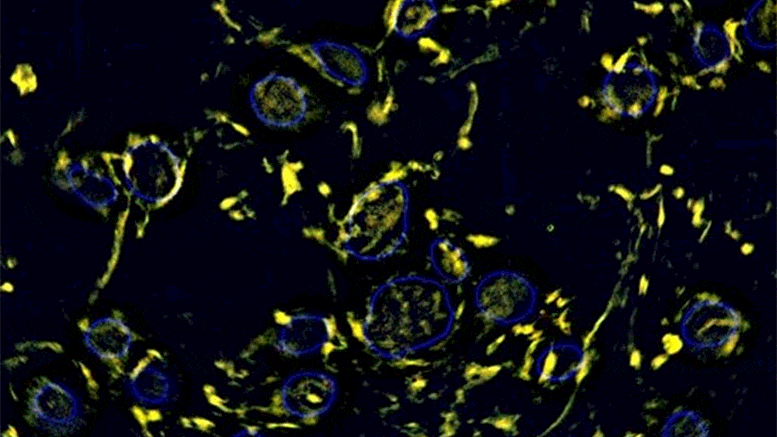Pesticide Exposure May Increase COVID-19 Susceptibility
0 View
Share this Video
- Publish Date:
- 26 April, 2021
- Category:
- Covid
- Video License
- Standard License
- Imported From:
- Youtube
Tags

ACE2 (yellow), the receptor for COVID-19, was more strongly expressed in the apical surface (left) when lung epithelial cells were exposed to organophosphates and IL-6. The right image shows less ACE2 expression on the basal surface. Apical surface expression causes more virus to adhere to the ACE2 receptor. Credit: Saurabh Chatterjee, PhD, University of South Carolina
Inflammation-induced mechanism may be associated with a higher risk of infection for veterans and people with metabolic disorders.
A new study conducted in human lung airway cells is one of the first to show a possible link between organophosphate pesticide exposure and increased susceptibility to COVID-19 infection. The findings could have implications for veterans, many of whom have been exposed to organophosphate pesticides during wartime.
Exposure to organophosphate pesticides is considered one of the possible causes of Gulf War Disease, a cluster of medically unexplained chronic symptoms that can include fatigue, headache, joint pain, indigestion, insomnia, dizziness, respiratory disturbances and memory problems. It is estimated that more than 25% of Gulf War veterans experience this condition.
“We have identified a basic mechanism related to inflammation that could increase susceptibility to COVID-19 infection in people exposed to organophosphates,” said Saurabh Chatterjee, PhD, of the University of South Carolina and a medical research specialist. the Columbia VA Medical Center and research team leader. “This mechanism may also increase the risk for people with metabolic diseases and cancer, as they often exhibit the same type of inflammation.”
Ayan Mondal, PhD, a postdoctoral researcher in Chatterjee’s lab, will present the research at the annual meeting of the American Society for Biochemistry and Molecular Biology at the Experimental Biology (EB) 2021 virtual meeting, taking place April 27-30. kept.
“The reason why COVID-19 causes a severe form of illness that leads to hospitalization and high death rates in a small segment of society is unclear,” said Prakash Nagarkatti, study co-author and vice president of research at the University. of South Carolina. “This work sheds new light on pesticide exposure and potential COVID-19 sensitivity due to altered immune response.”
In previous work, the researchers found elevated levels of interleukin 6 (IL-6) in samples from veterans and a mouse model of Gulf War Disease. The body makes these pro-inflammatory proteins to help fight infection and respond to tissue damage. However, the continued production of IL-6 can lead to chronic inflammation and has been shown to decrease the immune system’s response to viruses.
In the new study, the researchers wanted to know if exposure to the organophosphate pesticide chlorpyrifos and increased levels of IL-6 could increase the risk of SARS-CoV-2 infection. For six hours they exposed human lung airway epithelial cells to IL-6 or chlorpyrifos or both in combination. Another group of cells were not exposed to serve as a control.
The researchers then treated the cells with the spike proteins that cover the outside of SARS-CoV-2, the virus that causes COVID-19. During infection, spike proteins bind to our cells with angiotensin converting enzyme 2 (ACE2) receptors, initiating a process that allows the virus to deliver its genetic material into the healthy cell. The researchers found that cells exposed to IL-6 and the pesticide showed increased apoptosis – or controlled cell death – when the SARS-CoV-2 spike protein was present.
The cells exposed to both the pesticide and IL-6 also had significantly more ACE2 expression on the apical cell surface compared to cells not exposed or exposed to the pesticide alone. The apical membrane of airway cells faces the interior of the airway, while the basolateral membrane touches surrounding tissues. Increased ACE2 receptor expression on the apical surface means that more virus will attach to the cells.
“To our knowledge, this is the first study to show that the ACE2 receptor translates from the basolateral cell membrane to the apical cell when exposed to organophosphate and IL-6 simultaneously,” said Chatterjee. Since people with obesity, type 2 diabetes, or cancer also have high circulatory IL-6 levels, we believe that people with these conditions will also be more susceptible to SARS-CoV-2 infection due to the increased translocation of the ACE2 receptor to the apical cell surface.
The researchers say that while their results are preliminary, the work lays the groundwork for additional animal studies that could identify mechanisms of COVID-19 susceptibility in the general population and in veterans exposed to organophosphates. They plan to study organophosphate and IL-6 exposure, followed by administration of SARS-oV-2 spike protein in mice to better understand immune and organ responses.
Reference: “(R4434) Co-exposure to environmental organophosphate in pre-existing systemic inflammation may increase susceptibility to SARS-COV-2 infection in human lung epithelial cells” by Ayan Mondal, Aug. 26, 2021, Experimental Biology 2021.
The University of South Carolina’s Office of the Vice President for Research funded this research through a special internal funding initiative designed to encourage faculty to pursue innovative and new studies on COVID-19 across the university.










